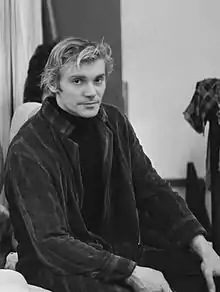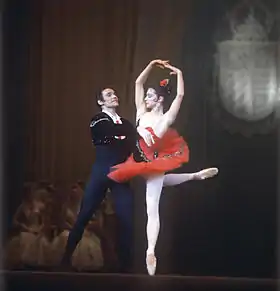Vladimir Vasiliev (dancer)
Vladimir Viktorovich Vasiliev (Russian: Влади́мир Ви́кторович Васи́льев), (born 18 April 1940) is a Russian ballet dancer and choreographer. He was a principal dancer with the Bolshoi Ballet and its director from 1995 to 2000.[1][2][3] He was best known for his role of Spartacus[4] and his powerful leaps and turns.[5] People's Artist of the USSR (1973).
Vladimir Viktorovich Vasiliev | |
|---|---|
 Vasiliev in 1972 | |
| Born | 18 April 1940 |
| Education | Moscow Ballet School |
| Occupation | Principal dancer Ballet director Choreographer |
| Spouse(s) | Ekaterina Maximova |
| Former groups | Bolshoi Ballet |
Vladimir Vasiliev was named "God of the dance"[6][7] and is regarded as a classical dancer on the same level as Rudolf Nureyev and Mikhail Baryshnikov.[8] At the height of their careers, Vladimir Vasiliev and Ekaterina Maximova were the golden couple of Russian ballet.
Early life
Vladimir Vasiliev was born in Moscow in 1940, the son of a truck driver. In 1947, at the age of seven, he joined the amateur ballet group of the Kirov pioneer group, where he stayed two years.[9] His first teacher was Elena Romanovna Rosse.
Vladimir Vasiliev entered the Moscow Ballet School, commonly known as The Bolshoi Ballet Academy, in 1947 and graduated in 1958, when he joined the Bolshoi Ballet. His teachers at the Moscow Ballet School included Aleksey Yermolayev.
Career
Principal Dancer with the Bolshoi Ballet
Vladimir Vasiliev became a principal dancer in 1959 in his second year with the Bolshoi Ballet.
Career with Ekaterina Maximova

Vladimir Vasiliev and Ekaterina Maximova, both principal dancers, were the dream couple of the Bolshoi Ballet. Dancing as a pair for the first time in 1949 as classmates at the Moscow Ballet School, they were married in 1961.[10]
New York Times dance critic Anna Kisselgoff described the excitement of one of Vasiliev's United States performances with the Bolshoi Ballet: “Yekaterina Maksimova and Vladimir Vasiliev burst upon New York City in 1959, the greatest of the passionate young dancers who, with Moscow's more established stars, made the Bolshoi Ballet's American debut a total triumph.”[11]
The Bolshoi tour to London in 1969 was dominated by the sensational impact of Aram Khatchaturian's ballet Spartacus as choreographed by Yuri Grigorovich, in which, wrote the leading critic Richard Buckle, "Maximova would melt any tyrant's heart".[12]
The great male dancer Mikhail Baryshnikov recently paid tribute to the couple, saying Maximova, with her "elegant build, beauty, virtuosity and even more so her spontaneity and sincerity", was treated like a "rare treasure" by the indomitable Vasiliev. This gave their performances an almost sacred aura, to which audiences gratefully responded.
Vladimir Vasiliev and Ekaterina Maximova gleaned wide exposure for their appearances in Franco Zeffirelli's filmed version of Giuseppe Verdi's opera La traviata of 1983. Both performed in Spanish costume, Vasiliev as a matador, in the "divertissements" composed for the equivalent of Act II, scene 2.
The couple was filmed in 1988 by French director Dominique Delouche in a film portrait “Katia et Volodia".[13]
In 2008, the Bolshoi hosted a week-long festival dedicated to Maximova and Vasiliev's 50 years on the Bolshoi stage, during which Vladimir Vasiliev commented that the secret of partnering was "the man must not get in the way of the woman – she is the most important person on stage." He added that all his life his wife had been his inspiration for two qualities: her beauty and her capacity for hard work.[12]
The marriage lasted for 50 years, until Ekaterina Maximova died in 2009. They had no children.
Director of the Bolshoi ballet
In March 1995 Vladimir Vasiliev was appointed the General and Artistic Director of the Bolshoi Theatre after Yury Grigorovich, artistic director of the ballet company since 1963, was dismissed by Russian President Boris Yeltsin.
Among the major projects Vasiliev has spearheaded there were such as the large scale exchange of Bolshoi and Mariinsky Ballet companies in 1998, of the Bolshoi and Paris Opera Ballet to be held, first-ever New Year Ball in the Bolshoi on 31 December 1999, foundation of the International Club of the Bolshoi Friends.[14]
At the end of the 1990s, he was one of the first ballet directors who recognized the class and the outstanding qualities of Svetlana Zakharova, then principal dancer with the Mariinsky ballet.[15] Svetlana Zakharova became a principal dancer with the Bolshoi Ballet in October 2003.[16]
Vladimir Vasiliev was dismissed as director of the Bolshoi Theater on 28 August 2000.[2] Vasiliev learned about his dismissal from hearing it on the radio.
Choreographer
Since his exit from the Bolshoi, Vasiliev premiered in the ballet production Lungo Viaggio Nella Notte di Natale, set to Tchaikovsky's music, in Opera di Roma, and continues to choreograph and stage new ballets.
Legacy
Vladimir Vasiliev is not as well known in the west as other iconic male dancers such as Rudolf Nureyev and Mikhail Baryshnikov, because he remained in the Soviet Union and did most of his work there. Nevertheless, his work as a classical dancer is regarded on the same level as both Nureyev and Baryshnikov.[8] Mathias Heymann, who was promoted to principal dancer with the Paris Opera Ballet in 2009 at only 22 years old, told in an interview that he takes inspiration from watching videos of Rudolf Nureyev, whom he regards as his role model, along with Vasiliev and Baryshnikov.
Russia's influential ballet critic and choreographer Fyodor Lopukhov called Vladimir Vasiliev "God of the dance" and "A miracle in art, perfection".
Performance style
On stage
Numerous roles were created for Vladimir Vasiliev, and he performed throughout the world, usually partnering his wife. Among the most notable were those created by Yuri Grigorovich, who gave him the principal roles in his original productions of The Tale of the Stone Flower, Spartacus, The Nutcracker, the ballet version of Ivan the Terrible, Valery Gavrilin's Anyuta (1982), and Yakov Eshpay's Angara (1976). Besides Maximova, Vasiliev's famous partners included Galina Ulanova, Maya Plisetskaya, Alicia Alonso, Carla Fracci, Rita Poelvoorde and Ambra Vallo.[1][2]
Style
Having a body revealing great physical strength, Vladimir Vasiliev did not embody the ideal physical form for a classical dancer.
He made enormous contributions to the development of classical male dance, embodying the strong new Bolshoi male.[1][2]
“You see — at the beginning we do things only as we have seen them done,” says Vladimir Vasiliev at the end of “Katia et Volodia,” the 1988 film exploring Vasiliev's artistry and that of his wife and fellow Bolshoi luminary, Ekaterina Maximova. “Afterwards, we do them with what we find inside ourselves.”[13]
Honours and awards
Vladimir Vasiliev is the first dancer to be given the award "La médaille d’or du meilleur danseur du monde" ("The Gold Medal of the World's Best Dancer") and also the only Grand Prix award winner at the Varna International Ballet Competition since winning the first competition in 1964.[17]
Over the years Vladimir Vasiliev has received many of the most prestigious Soviet, Russian and foreign prizes, orders and highest awards including the USSR State Prize, Russian State Prize, Order "For Merit to the Fatherland"[18][19] and State Order “For Merits” of France, Lithuanian State Order, Order of Rio Branco (Brazil), UNESCO Pablo Picasso Medal and others.
Filmography
See also
References
- Васильев Владимир Викторович. Great Soviet Encyclopedia
- Владимир Васильев. bolshoi.ru
- Cameron, Judy; Terry, Walter (1975). The Bolshoi Ballet. Harper & Row. p. 178. ISBN 978-0-06-430600-3. Retrieved 28 March 2011.
- The Bolshoi Ballet's Spartacus at Covent Garden, review by Mark Monahan, 20 July 2010: "Forty-two years ago, Vladimir Vasiliev, the original Spartacus, threw down what by all accounts was a fearsome gauntlet. But now, it is another, entirely unrelated Vasiliev - 21-year old Ivan, returning to London with the Bolshoi after a three-year absence - who is setting the standard."
- Vladimir Vasiliev is extraordinary in a 1960’s video of Goleizovsky’s ballet Leili & Madjnun, on Gramilano - Ballet, Opera, Photography.
- Katia et Volodia Filmporträt über Jekaterina Maximowa und Wladimir Wassiljew, film by Dominique Delouche from 1988, medici.tv.
- Vladimir Vasiliev - God of the dance, film, Vladimir Vasiliev's 12 best performances (42 min 12).
- Interview: Mathias Heymann, principal dancer with the Paris Opera Ballet, by Patricia Boccadoro, 2 November 2009, culturekiosque.com.
- Profile of Vladimir Vasiliev
- Prominent Russians: Ekaterina Maksimova, biography.
- Kisselgoff, Anna (16 May 1990) Review/Dance; Ballet Theater Welcomes Back A Pair of Longtime Bolshoi Stars. New York Times.
- Ekaterina Maximova The Telegraph, 28 Apr 2009.
- Celebrations in Cinema by a Longtime Aficionado of Point and Pliés, By Claudia la Rocco, The New York Times, 23 July 2008.
- General and Artistic Director, Bolshoi Theatre "God of the dance", profile of Vladimir Vasiliev.
- The embodiment of joy and beauty, article by Elena Fyodorenko, Russia Now, 11 June 2009.
- Monahan, Mark (15 July 2006). "The Jewel in the Bolshoi's Crown". The Telegraph. Retrieved 23 October 2015.
- "INTERNATIONAL BALLET COMPETITION – VARNA 1964". 30 Dec 2020.
- УКАЗ Президента РФ от 18.04.2000 N 691. document.kremlin.ru (2000)
- УКАЗ Президента РФ от 01.12.2008 N 1692. document.kremlin.ru (2000)
- Vladimir Vasiliev, profile
- The World Famous Stars of IBC – Varna, official site of the IBC.
- Katia & Volodia: A Portrait in Dance, the dvd was released in 2008, Daedalus DVDs.
External links
| Wikimedia Commons has media related to Vladimir Vasiliev. |
- Official website of Vladimir Vasiliev
- Vladimir Vasiliev in Spartacus 1972 (6 min 22)
- Vladimir Vasiliev - God of the dance, film, Vladimir Vasiliev's 12 best performances (42 min 12)
- Vladimir Vasiliev, profile